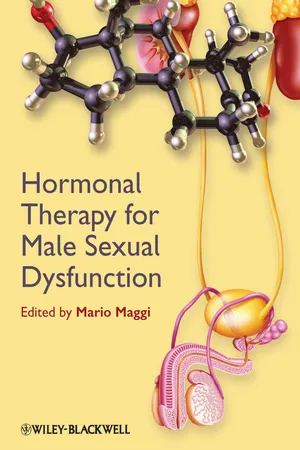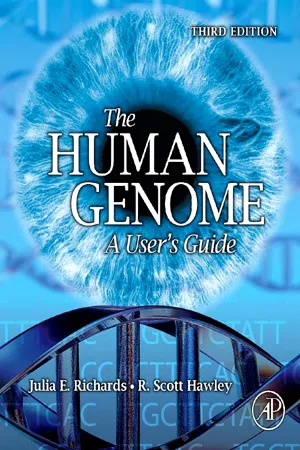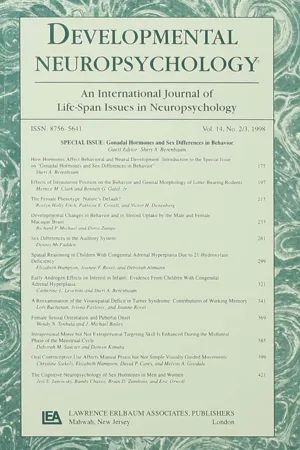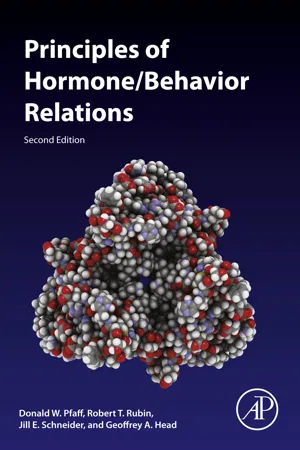Psychology
The Role of Chromosomes And Hormones In Gender
Chromosomes play a fundamental role in determining an individual's biological sex, with females typically having two X chromosomes and males having one X and one Y chromosome. Hormones, such as testosterone and estrogen, further influence the development of gender-specific traits and behaviors. While chromosomes provide the initial blueprint for sex differentiation, hormones contribute to the physical and behavioral characteristics associated with gender.
Written by Perlego with AI-assistance
Related key terms
11 Key excerpts on "The Role of Chromosomes And Hormones In Gender"
- eBook - ePub
- Justin J. Lehmiller(Author)
- 2017(Publication Date)
- Wiley-Blackwell(Publisher)
On a side note, we will use terms such as “male body” and “female body” throughout this chapter to refer to the overall set of physical characteristics that distinguish biological males from biological females. However, as mentioned above, not everyone who has a “male body” identifies as male, just as not everyone who has a “female body” identifies as female. Thus, keep in mind the very important distinction between these biological and psychological aspects of the self.Biological Influences on Gender Identity and Sexuality
Our biological sex is a function of three separate components: our chromosomes, gonads, and hormone levels. These factors work together to differentiate the bodies and brains of biological males and females. See Table 5.1 for a summary of the typical sequence of biological events that occurs in each sex. Chromosomal sex refers to the specific combination of sex chromosomes contained within our genes. Chromosomal sex is determined at the moment of conception (i.e., when a sperm cell fertilizes an egg). Typically, egg cells carry a single X-chromosome, while sperm cells carry either a single X- or Y-chromosome. If the resulting combination is XX, fetal development will proceed toward the female form; if the resulting combination is XY, development will proceed toward the male form.Typical sequence of biological sex differentiation.Table 5.1Level of sex differentiation Male Female Chromosomal sex XY XX Gonadal sex Testes Ovaries Hormonal sex Androgens Estrogens Sexual anatomy Fully developed penis and scrotum, as well as their corresponding internal reproductive structures Fully developed vulva, as well as its corresponding internal reproductive structures Sexually dimorphic brain Larger preoptic area and bed nucleus of the stria terminalis (BNST) Smaller preoptic area and bed nucleus of the stria terminalis (BNST) Gonadal sex refers to the specific gonads (i.e., ovaries vs. testes) present within the body. The gonads begin to develop in response to genetic signals approximately six weeks after conception. Once developed, the gonads begin releasing sex hormones. Hormonal sex refers to the major class of hormones released by the gonads: estrogens (primarily released by the ovaries) or androgens (primarily released by the testes). As mentioned in Chapter 4 - eBook - ePub
Sex Differences in Cognitive Abilities
4th Edition
- Diane F. Halpern(Author)
- 2013(Publication Date)
- Psychology Press(Publisher)
Researchers have identified three interrelated biological systems that could be responsible for cognitive sex differences: (1) chromosomal or genetic determinants of sex; (2) differences in the sex hormones secreted from the endocrine glands and other structures; and (3) neuroanatomical differences in the structure, organization, and/or function of the brain. Theories and research on the biological determinants of sex-related cognitive differences have centered on these three biological systems. Like any division in biology, these are not separate systems; genes and hormones presumably operate on behavior via some neurological mechanism, and differences in sex hormones are largely (but not entirely) dependent on genetically coded information. The brain develops in a hormonal milieu, bathed in prenatal hormones that are under the control of genetic codes. In keeping with the biopsychosocial framework introduced in the first chapter, keep in mind the environmental context in which the biology of maleness and femaleness expresses itself. There are many environmental variables that affect brain structures and the type and quantity of hormones that are excreted into the bloodstream, thus blurring the distinction between biological and environmental variables.One of the major difficulties in understanding the contribution of each of these biological systems is that in normal individuals they are confounded. Chromosomes determine the type of sex hormones that are secreted, and these hormones influence brain development. Sex hormones also direct the development of the internal reproductive organs and external genitals. Thus, for most people, all of the biological indications of sex are congruent and interdependent. Although these three systems exert influences on each other, one way to comprehend these intricately enmeshed biological systems is by examining each system separately and then putting them back together to understand how they work in concert. Possible genetic and hormonal influences are presented in this chapter. Brain mechanisms and links among these three systems are presented in Chapter 5 . The question for research psychologists is whether any or all of these biological sex differences underlie cognitive sex differences, and if so, how much and in what ways.BEHAVIORAL GENETICS
Genes are like musical instruments. Genes don’t determine exactly what music is played—or how well—but they do determine the range of what is possible. —Dean Hamer and Peter Copeland (1998, p. 12)Like many other fields of study, psychology is feeling the effects of the explosion of new research and methods in genetics. Investigators in the field of behavior-genetics look for evidence of linkages between genetic information and complex human behaviors. Genetic material is the basic building block of life. Fetal development proceeds under the direction of the genetic information coded in the genes. Whether you were born male or female with black or white skin and blue or brown eyes was determined by the chromosomes and genes that are responsible for your very existence. The traits that you inherited from your ancestors were transmitted via your genes. Genetic information constitutes the “genotype” of an individual, while traits that are expressed are called the “phenotype.” Phenotype is what we see—either in terms of physical appearance or behavior. Phenotype depends on the interaction of genes with environmental influences. The term “gene–environment transaction” is sometimes used to emphasize the fact that most behavioral traits that are expressed depend on the mutual effect of genetic and environmental influences. Researchers use observable characteristics (phenotypes) to infer genetic information (genotypes). There are four research strategies commonly used to study the influence of genetic information on cognition (adapted from Eliot & Fralley, 1976): - eBook - ePub
Gender, Sex and Sexuality
Contemporary Psychological Perspectives
- Gerda Siann(Author)
- 2013(Publication Date)
- Taylor & Francis(Publisher)
In the very great majority of human births, the unambiguous assignment into one of the categories, female/male, is clearcut but, as all societies have been aware, occasionally individuals are born who prove exceptions to this general rule and who have the sexual characteristics of both sexes. It is the existence of such exceptions that has led to much of the scientific investigation into how sexual differentiation occurs in human development. In the next sections we shall first look briefly at how sexual differentiation is affected by two areas into which there has been a great deal of investigation - the sex chromosomes and hormones. This will be followed by a discussion of individuals whose sexuality is physiologically ambiguous.The chromosomes
As most people know, the transmission of hereditary characteristics in human beings is carried on the chromosomes which form part of the nuclei of cells. In humans there are 23 pairs of chromosomes. One member of each pair is contributed by the mother and one by the father when the egg and the sperm unite at conception. Twenty-two of these pairs carry the genes which determine various features of the individual, the remaining pair are termed the sex chromosomes While the rest of the chromosomes are roughly identical in shape, the two forms of the sex chromosomes, known respectively as X and Y chromosomes, differ considerably in shape and size. The first of these, the X chromosome is larger and carries more genetic material. These sex chromosomes are produced by organs called the gonads, the ovaries in females and the testes in males. The ovaries can produce only X chromosomes but the testes can produce both X and Y chromosomes. If an X unites with another X, the chromosomal sex of the baby will be female (XX), while if an X unites with a Y, it will be male (XY) so that it is the father who determines the chromosomal sex of the child.While the Y chromosome is much smaller than the X and while, as noted above, it carries relatively little genetic information, it does contain a gene (or possibly genes) which cause the production of hormones and these hormones transform the XY baby’s originally undifferentiated gonads into testes. In the case of the XX baby, the gonads develop into ovaries. - eBook - ePub
- Susan Stryker, Stephen Whittle, Susan Stryker, Stephen Whittle(Authors)
- 2013(Publication Date)
- Routledge(Publisher)
Gender role is the overt behavior one displays in society, the role which he plays, especially with other people, to establish his position with them insofar as his and their evaluation of his gender is concerned. While gender, gender identity, and gender role are almost synonymous in the usual person, in certain abnormal cases they are at variance. One problem that arises to complicate our work is that gender behavior, which is for the greatest part learned from birth on, plays an essential part in sexual behavior, which is markedly biological, and at times it is very difficult to separate aspects of gender and sex from a particular piece of behavior.Let us look now at some of the biological aspects of human sexual and gender behavior. This discussion will not review the physiology of sexual excitement, orgasm, and like subjects. While these have been studied in great detail (by far the most important work being that of Masters and Johnson and the excellent review by Sherfey), I am here more concerned with central than with (anatomically) peripheral mechanisms. Nor will the biology of the anatomic development of one's primary and secondary sexual characteristics be considered further here. As with the material I sketched in on lower animals, it is possible only to sample representative work in humans in order to give an impression of the information presently becoming available.First, from the work of geneticists: While many of us are still awaiting definitive information about the contributions that chromosomes and genes make to sex and gender behavior, there are geneticists who might consider that our waiting shows undue skepticism. Certainly there have been exciting discoveries in the genetic laboratories in the last decade or so. The discovery by Barr and Bertram of nuclear sex chromatin material in mammalian, including human, cells has given us a simple, rapid, and highly accurate screening test for genetic sex. Also, new techniques for visualizing chromosomes have revealed to us both the normal complement of 46 chromosomes to the human cell and the presence and morphology of the sex chromosomes. This immediately made possible some clarification of the contribution of chromosomes to intersexuality (e.g., the XO Turner's Syndrome of ovarian agenesis or the XXY of the typical Klinefelter's Syndrome). In addition, decades of speculations regarding the alleged role of gross chromosomal anomalies in perversion with gender abnormality were put to rest when it was shown that no such defects were demonstrable—for example, in homosexuality or transvestism. - eBook - ePub
- Judith E. Owen Blakemore, Sheri A. Berenbaum, Lynn S. Liben(Authors)
- 2013(Publication Date)
- Psychology Press(Publisher)
Why should we expect genes and hormones to affect behavior, including gender-related behavior? Put simply, the brain is part of the body and the brain underlies behavior, so it should not be surprising that the same factors that govern sexual differentiation of the body also govern sexual differentiation of the brain and thus behavior. Furthermore, the process of physical sexual differentiation is essential to the survival of our species—reproduction depends on all of these processes working normally. Given their importance, it seems reasonable to theorize that these processes also play a role in psychological sexual differentiation— and, in fact, this is the basis for biological theories of gender development. A role for biology in gender development will not be surprising to those of you who have taken courses in biology, neuroscience, and biologically oriented psychology courses. But, for a long time some social scientists were resistant to the idea that biology could affect behavior, in part because they assumed that biology was equivalent to “determined.” We know now that there is almost nothing about biology that is determined, that is, many biological processes are affected by what we do and the physical and social environment in which we live. It will help to keep this in mind as we describe biological influences on gender development.Biological theories of gender development are generally not as formally developed as are the social or cognitive theories that we will discuss in later chapters and thus they might be better called biological approaches or biological perspectives. Biological approaches provide explanations of gendered psychological characteristics using the same biological processes that explain sex-related physical characteristics. As discussed in chapter 3 , this includes immediate or proximal causes—sex chromosomes, genes, and sex hormones—and historical or distal ones—evolutionary processes.Distal explanations of gender development concern the evolutionary basis of characteristics that differ between the sexes, particularly characteristics that increase the likelihood that an organism will obtain a mate, reproduce, and rear offspring who themselves reach reproductive age. Those characteristics are most important in adolescence and adulthood, so evolutionary perspectives on gender development primarily concern psychological sex differences in adulthood. For this reason, we will not devote as much space to these perspectives as we will to other biological perspectives. Proximal explanations - eBook - ePub
- Mario Maggi, Mario Maggi(Authors)
- 2011(Publication Date)
- Wiley-Blackwell(Publisher)
et al . 2011.SCIENCE REVISITEDGender identity : a persons’ sense of self as being male or female.Gender role : behaviors, attitudes, and personality traits that a society, in a given culture and historical period, designates as more typical of the male or female social role.Disorders of Sex Development (DSD ) (previously referred to as intersex conditions): congenital conditions in which the development of chromosomal, gonadal, and/or anatomical sex are not entirely male or female.Gender dysphoria : is the distress resulting from conflicting gender identity and gender of assignment.Transsexualism or gender identity disorder : extreme end of the spectrum of gender dysphoric conditions, usually characterized by a pursuit of sex reassignment.A typical development of gender identity and gender role behaviorResearch on factors that influence typical gender development generally focuses on gender role or gender related behavior. We have already seen that in non-clinical groups, prenatal exposure to higher levels of androgens may lead to more masculine behavior. Because gender identity usually develops in accordance with an uneventful sexual differentiation, it is difficult to study factors that may influence gender identity development in typically developing individuals. However, studies in individuals with atypical prenatal hormonal levels or individuals that have a gender identity that is not in accordance with their natal sex could help in elucidating the mechanisms underlying gender identity development. Three groups are of interest: children of mothers who took medication during their pregnancies that might have influenced their children’s gender development, individuals with disorders of sex development, and transgender individuals. - eBook - ePub
Psychology and Gender
An Advanced Reader
- Sadhana Avinash Natu(Author)
- 2023(Publication Date)
- Routledge India(Publisher)
Before we explore all the theories and approaches, it is important to note that feminist scholarship and research have demonstrated that there are more similarities between men and women than differences. Hyde (2014) proposed that men and women are similar on most psychological variables. She called this the ‘ gender similarity hypothesis’. Also, Tavris (1993) wisely concluded in her book The Mismeasure of Woman, ‘Women are not the better sex, the inferior sex, or the opposite sex,’ which is important in terms of understanding the debates and points of view. All in all, various social sciences, biology, and medicine have had different points of view about sex, sexuality, and gender, as well as gender role development. It is important to understand the similarities, differences, and gender critique of all these theories. The present chapter aims to give a bird’s-eye view of these theories. 2.1 Biological Approach Hormones, the nervous system, and neurotransmitters are some of the biological influencers of gender role development and behaviour. Let us understand these aspects one by one. Male hormones are androgen and testosterone, and female hormones are progesterone and oestrogen. Male and female hormones are found in and are important for both males and females. The idea that hormones have gender is a myth (Crocetti, 2013). That testosterone levels are related to aggression has also been proved to be a myth; testosterone powers the drive to achieve social dominance, whereas societal factors and a congenial cultural atmosphere normalize male violence. In fact, interestingly, aggressive behaviour leads to an increase in testosterone levels in males and so does interaction with a gun! This means that the explanation that high levels of testosterone make males behave aggressively is not true - eBook - ePub
- Julia E. Richards, R. Scott Hawley(Authors)
- 2010(Publication Date)
- Academic Press(Publisher)
Secondary sexual characteristics are those sexually dimorphic characteristics that are not directly involved in reproduction. For males, secondary characteristics include facial and chest hair, increased body hair, pelvic build (lack of rounded hips), upper body muscular build, and the ability to generate muscle mass at a faster rate than the female. For females, secondary sex characteristics include relative lack of body hair, thicker hair on the head (in some cases), rounded hips/figure, a decreased ability to generate muscle mass at a fast rate, decreased upper body strength, breasts, ability to nurse children, a menstrual cycle, and increased body fat composition. There are, of course, exceptions to any efforts to use a list of features to classify people into the conventionally defined sex categories. For instance, not all women succeed in breast-feeding their infants, even if they otherwise fit the conventional definition of female.Having defined biological sex in terms of chromosomes, genes, hormones, and organs, let’s begin dissecting the process of sexual differentiation.8.2. What Do the X and Y Chromosomes Have to Do With Sex?As we noted in Chapter 7 , a genetically normal human being contains 23 pairs of chromosomes, the 22 pairs called autosomes and one pair called sex chromosomes (the X and the Y). A normal female possesses two X chromosomes, whereas a normal male possesses one X and one Y chromosome. The finding of XXY males and X0 females convinced geneticists that sex in humans was determined solely by the presence or absence of a Y chromosome (Table 8.2 ), and that it was not determined by the number of copies of the X chromosome. This is especially interesting because, as you will recall from the Appendix in Chapter 6 - eBook - ePub
- Ursula Mittwoch(Author)
- 2014(Publication Date)
- Academic Press(Publisher)
Since their discovery in insects at the turn of the century, sex chromosomes have been found in a vast number of organisms. Today, the statement that the sex chromosomes act as differentiators of sex in the majority of animals is merely a commonplace. Although the question of what determines the sex of an organism has thus been answered in a formal way, very little is known about the mechanism which underlies the action of the sex chromosomes. Therefore, any hypothesis attempting to explain such action must at present be in the nature of speculation.Sex chromosomes are a feature of higher organisms, and to fulfil their function they must somehow modify the development of such organisms. Since different animals vary widely in their embryonic development, it is inevitable that the action of the sex chromosomes will vary accordingly. In insects, there is evidence that the sex chromosomes act directly on the cells which contain them. This is strikingly illustrated by the existence of gynandromorphs in Drosophila , in which aggregates of cells with an XX- and with an XO-chromosome constitution can be recognized by the expression of female and male characteristics, respectively. A direct effect of the sex chromosomes on sexual development exists also in the silkworm, Bombyx mori (Tazima, 1964 ). It is clear that such a straightforward relationship between sex chromosomes and phenotype cannot exist in vertebrates, in which sexual characteristics result from the action of hormones and the capacity of tissues to react to them (see Burns, 1961 ; Wolff, 1962 ; Corner, 1947 - eBook - ePub
Gonadal Hormones and Sex Differences in Behavior
A Special Issue of developmental Neuropsychology
- Sheri A. Berenbaum, Sheri A. Berenbaum(Authors)
- 2014(Publication Date)
- Psychology Press(Publisher)
Consistency of findings across methods and species continues to provide support for two fundamental principles in psychoneuroendocrinology. First, sexual differentiation of the mammalian brain and behavior parallel sexual differentiation of the body: High levels of androgens (and metabolites) present during critical periods cause development to proceed in a masculine direction, whereas low levels produce feminine development. Second, hormones exert behavioral effects at various times in development through permanent changes in the wiring and sensitivity of the brain (organizational effects) and through ongoing changes to neural circuitry (activational effects). Although these two principles remain correct in broad form, recent work in both human and nonhuman species—much of it presented in articles in this special issue—reveals complexities and provides questions and answers about the ways in which hormones affect behavior.Several articles in this special issue expand our knowledge about the effects of early (organizational) hormones on a variety of behaviors and aspects of brain structure and function in a variety of species. These studies reflect the range of methodology available to study the behavioral effects of early hormones. Clark and Galef (this issue) show that, in rodents, a variety of behavioral, morphological, and reproductive characteristics are affected by intrauterine position, which reflects exposure to variable levels of testosterone. Their results encourage studies of human opposite-sex twins (as illustrated in the work of McFadden, this issue), and remind us of the value of examining both physical and behavioral traits, and the complexity of hormonal effects on behavior, including the importance of hormone sensitivity and environmental responses to the organism. Fitch, Cowell, and Denenberg (this issue) clearly demonstrate that sexual differentiation is not determined simply by the amount of androgens present in early development, but depends on an active feminizing process induced by ovarian hormones. Michael and Zumpe (this issue) describe how steroid hormones are taken up in the primate brain, and suggest that masculinization occurs at least in part through the conversion of testosterone to estradiol. McFadden (this issue) provides a comprehensive review of sex differences in the human auditory system and indicates how hormones present at several times in development are likely to be responsible for these sex differences. He also demonstrates the value of examining hormonal influences on basic sensory and perceptual processes. - eBook - ePub
- Donald W. Pfaff, Robert T Rubin, Jill E. Schneider, Geoff Head(Authors)
- 2018(Publication Date)
- Academic Press(Publisher)
sex is biological. The word applies to most animal species and has many components: chromosomal sex (e.g., whether a mammal has two X or X and Y chromosomes), gonadal sex (whether one has ovaries or testes), hormonal sex (whether the brain and body are exposed to high or low levels of gonadal steroids during early development), internal genital sex (whether an animal has seminal vesicles and vas deferens or fallopian tubes), genital sex (whether a mammal has a penis and scrotum or clitoris and vaginal labia), and behavioral sex. Behavioral sex is relevant to any species in which there are sex differences in behavior. Many behavioral sex differences are in reproductive behaviors, but these differences can affect other types of behaviors, including parental, agonistic, and cognitive. In any particular individual all these components of sex may be male, female, or mixed, so in one individual the sex chromosome complement might be XY male but hormonal sex may be female (e.g., no functional androgen receptors (ARs)). Behavioral sex also has many components.In human subjects, sex and gender are difficult to untangle. Behavioral sex/gender differences appear in childhood play behavior (males tend to engage in significantly more rough-and-tumble play and prefer different toys), preferred gender roles (females tend to prefer the role of mother or princess, whereas males tend to prefer the role of father or king), and gender identity (whether one thinks of oneself as male or female). Sexual orientation can be seen as partially related to sex differences but also unrelated to them, and therefore there are four or more categories of sexual orientation. For example, individuals can have a female gender identity and heterosexual orientation, a female gender identity and homosexual orientation (lesbian), a male gender identity and heterosexual orientation, or a male gender identity and homosexual orientation (gay male). The genetic, hormonal, and physiological influences on homosexuality differ depending upon whether the subject is a lesbian (homosexual woman) or a gay male (homosexual man). Some lesbians classify themselves as “butch” if they have masculine traits or “fem” if they have feminine traits. Furthermore, within males or females these are not simple, binary categories, and thus different degrees of masculinized gender identity and sexual orientation are possible, and these are not fixed in time. Individuals change orientation, and some change their sex and/or gender identity with surgery and/or hormone treatment (e.g., this may be true of some transsexuals). Some individuals, for example, have a partially masculinized female gender identity and bisexual orientation, whereas others have a feminine gender identity and bisexual orientation. As is indicated by the term “gender identity,” these human behaviors are influenced to an unknown degree by genes, hormones, and the environment. Nevertheless, the preponderance of evidence shows that they have a strong biological component. It has been challenging to tease apart these influences, and comprehensive treatments are found in books and review articles by prominent behavioral neuroendocrinologists (Balthazart, 2011a , b; Berenbaum and Meyer-Bahlburg, 2015 ; Hines et al., 2015
Index pages curate the most relevant extracts from our library of academic textbooks. They’ve been created using an in-house natural language model (NLM), each adding context and meaning to key research topics.










